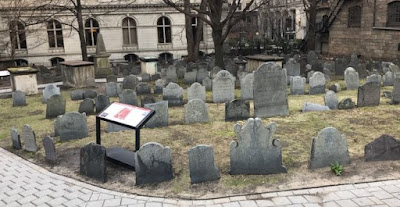King’s Chapel Burying Ground is the oldest cemetery in the city of Boston. It was established in 1630 when Sir Isaac Johnson sold the land on which he formerly maintained his vegetable garden to create the city’s first burial ground. It is said that Mr. Johnson was the first individual buried here. For almost thirty years, it remained the only burial ground in Boston until 1659 when Copp’s Hill Burying Ground was established in the North End. It is not known exactly how many individuals were buried here between the years 1630 and 1896, however, it is known to be well over a thousand. It’s estimated that for every one of the 500-600 headstones still in existence that ten to twenty burials occurred.
 |
| King’s Chapel Burying Ground |
King’s Chapel is reported to be one of the most haunted locales in all of Boston. Legends tell of an individual once buried alive here. By the time suspicions were raised and the body dug up, the person was already dead—whether before or after having been buried it is uncertain. Another ghastly tale speaks of a person whose head had to be chopped off in order to fit within their undersized coffin. And last but not least, Captain Kidd has even been rumored to be buried within this graveyard. This would appear highly unlikely, though, as he was hung in London after being convicted of piracy.
While taking a stroll throughout King’s Chapel Burying Ground, you may find:
- The ornately carved gravestone of one Joseph Tapping.
- The grave marker which supposedly was the inspiration for The Scarlet Letter.
- A grave belongs to “the other” Midnight Rider.
- The oldest extant grave within the cemetery.
- The final resting place for the 1st woman to step off the Mayflower.
- The grave for the 1st governor of Massachusetts.
During your explorations if you really wish to experience what death may smell like, we encourage you to stick your nose up close to the wrought iron structure situated in the southwest corner of the yard. This is a structure which seems to attract and puzzle many visitors in the graveyard. This is actually a ventilation shaft for the nearby Park Street Station, which was erected in 1896.
- Website: http://www.thefreedomtrail.org/visitor/kings-burying.html
- Address: 58 Tremont Street, Boston, MA (Address is approximate)
- Cost: Free
